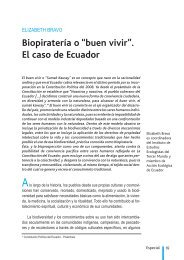BIOPIRACY Imitations Not Innovations - Biopirateria
BIOPIRACY Imitations Not Innovations - Biopirateria
BIOPIRACY Imitations Not Innovations - Biopirateria
You also want an ePaper? Increase the reach of your titles
YUMPU automatically turns print PDFs into web optimized ePapers that Google loves.
Biopiracy: <strong>Imitations</strong> <strong>Not</strong> <strong>Innovations</strong> 21<br />
assess the potential for income generation. The study was conducted in three<br />
communities of Assam — Ahom, Mishing and Tiwa. The Ahoms who practise<br />
wet paddy cultivation have been found to possess a rich knowledge of the use<br />
of herbs as medicines. The knowledge medicinal herbs and treatment of ailments<br />
has been found to be rather specialized, limited to a few members of the<br />
community. Most of the old women know the use of herbal medicines to cure<br />
diseases related to childbirth, menstruation etc. A total of 120 plants were<br />
found to be used by the Ahoms for various medicinal purposes. The Mishings,<br />
the second largest group of Scheduled tribes in Assam, also practise agriculture.<br />
The Mishing villages are located in far-flung riverine areas and have to depend<br />
mostly on their IK of herbs to deal with various diseases and illnesses. A total<br />
of 190 plants were mentioned in the survey questionnaires as being used by<br />
them for medicinal purposes. The Tiwas who practice shifting or jhum cultivation<br />
in the hills and paddy cultivation in the plains have been found to use about<br />
135 plants for medicinal purposes. However, this knowledge is gradually eroding<br />
among the plain Tiwas who have forgotten their languages and their overall<br />
living pattern has changed because of close interaction and assimilation with<br />
non-tribals.<br />
Another thing to be kept in mind for the prevention of piracy of bioresources<br />
and associated IK is that legal protection be granted to them in both the<br />
provider and user countries. This aspect has been touched upon earlier. For<br />
instance, the Patents Act of India, 2005 provides that mere discovery of any<br />
living thing or non-living substances occurring in nature shall not be considered<br />
to be an invention. The Act further provides that an invention which in effect<br />
is traditional knowledge or which is an aggregation or duplication of known<br />
properties of a traditionally known component or components shall not be<br />
considered to be an invention. However, if India, in a given situation, is a<br />
provider country of bioresource and/or associated IK, then these well-meaning<br />
provisions will be of no use unless the legal system of the user country has legal<br />
provisions that also acknowledge this. The weakness in the system is that<br />
intellectual property law has only domestic jurisdiction, and the intellectual<br />
property concept enunciated under the TRIPS Agreement does not compel its<br />
member nations to acknowledge provisions like disclosure of origin and prior<br />
informed consent.<br />
As a first step, action is needed at the national level, in policy and legislation,<br />
in different countries to protect IK.<br />
There is a lot of debate on the systems of protection that can be adopted<br />
to provide legal protection to the intellectual property of indigenous people and<br />
communities. Most of these discussions have tried to adapt the existing forms of



